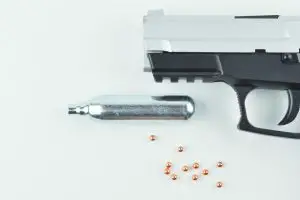Air pistols are very popular for target shooting and pest control or for hunting small game. But how do air pistols work? Find out below.
The Basic Functioning of Air Pistols
Air pistols are designed for recreational shooting, training, and sometimes even small game hunting. The basic functioning of air pistols involves several key components and processes.
Air pistols ultimately propel pellets or bbs out of the barrel at high speeds. This is done by first compressing air in the air pistol’s main body. The air is then released, which causes the pellet or bb to be fired out of the barrel. Here’s a further overview of how this process works:
- Power Source: Air pistols use various power sources to generate the force required to propel the projectiles. The most common types are Spring Piston, CO2 (Carbon Dioxide), and PCP (Pre-Charged Pneumatic)
- Loading Mechanism: Air pistols have different loading mechanisms depending on the model and design. The two common types are Break Barrel and Magazine-Fed.
- Firing Process: Once the air pistol is cocked and loaded, the firing process generally involves the following steps: Trigger Pull, Valve Operation, and Pellet Propulsion. The compressed air or gas forces the pellet through the barrel, providing it with the necessary velocity. The pellet exits the barrel, propelled by the expanding gas or the energy released from the compressed air.
- Safety Mechanisms: Air pistols are equipped with various safety mechanisms to prevent accidental firing. Common safety features include manual safeties, trigger safeties, and automatic safeties that engage when the gun is not in use or is being carried.
It’s important to note that air pistols should be handled responsibly, following all relevant laws, regulations, and safety guidelines. Always familiarize yourself with the specific operating instructions and safety features of your particular air pistol model.
Air Pistol Reload Mechanisms
Air pistols, just like their sibling air rifles, shoot pellets or bbs at very high speeds. They come in three different types of reloading mechanisms:
- Spring-powered pneumatic
- C02 / gas powered
- Electric Automatic
Air pistols work largely the same as regular pistols. A large amount of energy is needed to send the round down the barrel and to the target at high speed. However, air pistols are provided with compressed air, gas, or C02 instead of gunpowder.
Air pistols can be very accurate, even at far distances if enough air pressure is provided when firing the round. This is why they are used for marksmanship training and practice, as well as hunting small game.
How Do C02 Air Pistols Work?
C02 air pistols are supplied power with a C02 container that has pressurized carbon dioxide. C02 pistols can repeat shoot without having to be pumped again and again each time. These are great for fast shooting and target practice.
A C02 pistol will gradually decline in power as the pressure runs out. This is when the C02 cartridge needs to be replaced. If there is not enough C02 left, then the pistol will not effectively fire.
C02 pistols will not operate well below 70 degrees or above 100 degrees Fahrenheit. So, they are not suited for extremely cold or hot environments. For those, a spring-loaded, pump-action pistol is better.
C02 tanks are a very common way of supplying air pistols with power. However, there are now different types of air pistols with their own mechanisms.
How Do Piston Powered Air Pistols Work?
Piston pneumatic air pistols are those that refill their air pressure by way of a hand pump action. Generally, these pistols are very powerful and can shoot a BB or pellet at high velocities. The air pressure in the reservoir is what drives the pellet out of the barrel and thus, the higher the air pressure, the faster the pellet will travel.
Piston-powered air pistols include either multi-pump or single-stroke pneumatic. These can be over-lever or under-lever (above or below the barrel).
An example of a pneumatic single-stroke air pistol is the .177 Beeman P17 OverLever Pellet Pistol.
How Do Gas-powered Air Pistols Work?
Some air pistols use gas or propane to power the gun. These are prefilled canisters that are refilled at a gun shop or with a pressured gas tank. They work the same way as C02-powered air pistols, in that the compressed gas sends the pellet or bb down the barrel. When the trigger is pulled, the gas is released into the chamber which propels the round at hundreds of feet per second.
How Do Electric Air Pistols Work?
Electric air pistols operate similarly to other types of air pistols. However, they use a small, electrically driven air compressor to supply air to an airgun cylinder. The airgun cylinder stores a certain amount of air pressure, and when the trigger is pulled, that compressed air is released into the barrel of the gun, propelling the pellet or BB downrange. They require electrical batteries to provide power to the internal motor and piston mechanism.
This brings up another important question, Are Air Pistols Safe?
To Close
Air pistols are great for first-timers (especially kids) to learn how to shoot a gun safely, as well as for those looking for a fun way to target shoot. Choosing the right type of air pistol depends on your needs and requirements. Just make sure to be safe when handling these firearms as they can cause serious injury or even death.
- RWS Air Gun Shooter’s Gun Cleaning Kit and Targets Review - July 26, 2023
- Motanar .177/.22 4.5mm/5.5mm Air Rifle Barrel Cleaning Kit Review - July 26, 2023
- Raiseek .177 Cal & .22 Cal Airgun Cleaning Kit Review - July 26, 2023

